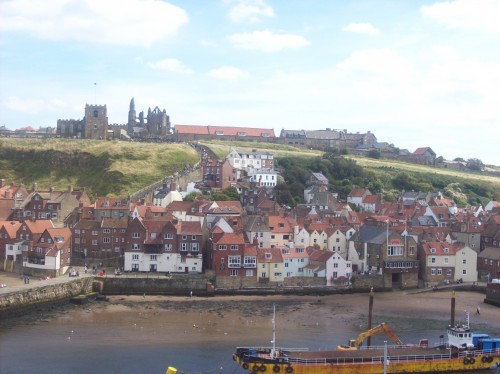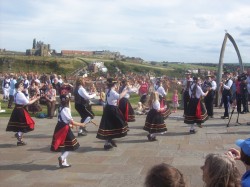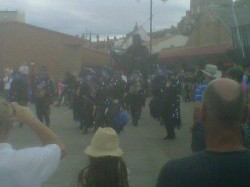
It’s little wonder that Whitby has long drawn the folklorists and the fabulists.
Perched on the coast of north-easternmost Yorkshire, it is a remote town. Even in the age of the motor-car it is like travelling to a different world, driving over the hills and the beds of heather on which lie dormant the wild and native spirits of the North York Moors. The journey across the landscape is the change of key, the segue between those dying moments before sleep and the start of a dream.
Katie from Leeds Grub drove me along the A64 today with her mother and sister. When she’s not sampling the finest cuisine and attending real ale nights around West Yorkshire, Katie joins a local morris dancing team, the Briggate Women’s Northwest Morris.
Morris dancing has a rich, sometimes misunderstood, inevitably little-known heritage. Its roots in England are said to belong with the early modern peasantry: morris dancing was indeed one of the festivities suppressed by Cromwell as a distraction from the path towards God.
 Perhaps as a reaction to the urbanization brought by the Industrial Revolution, some communities made an effort to reclaim this symbol of their agrarian folk heritage. To this day, the tradition survives – and is watched and celebrated by the kind of bewildered passers-by caught up in the thick of it whilst holidaying and hen-nighting in Whitby today.
Perhaps as a reaction to the urbanization brought by the Industrial Revolution, some communities made an effort to reclaim this symbol of their agrarian folk heritage. To this day, the tradition survives – and is watched and celebrated by the kind of bewildered passers-by caught up in the thick of it whilst holidaying and hen-nighting in Whitby today.
This week, the seaside town hosts its annual folk festival, the Whitby Folk Week: over six hundred different events including singalongs and street performances, concerts and ceilidhs.
Where else, you might ask, but Whitby? The town revels in its difference, its unbelonging, its distance. Once upon a time more accessible by sea than by road, the ethereal music of the morris pipes and fiddles swoons amid the coastal breeze in Whitby just as naturally as the whispering Esk.
Its abbey was where Caedmon was said to have been inspired by God to become the first to write poetry in English, “godcundlice gefultumod ond þurh Godes gife þone songcræft onfeng”. Its coast was where HMS Endeavour was built, before Captain Cook took charge on its voyage to Australia and New Zealand. Its shore is where the ill-fated Russian ship Demeter runs aground in Bram Stoker’s Dracula, revealing the mysterious story of its Transylvanian cargo. Nowadays, it’s even become the favoured haunt of black-clothed, white-painted Goths from far and wide.
 Today, Katie and others across the country go along for the sheer revelry more than anything else. Morris dancers of every style and tradition come to the festival and others like it – from the North West morris familiar to Lancashire and West Yorkshire, to the Border morris from Shropshire, Herefordshire and Worcestershire, whose blackened faces and flamboyant dress were enough to frighten young children across Whitby all day.
Today, Katie and others across the country go along for the sheer revelry more than anything else. Morris dancers of every style and tradition come to the festival and others like it – from the North West morris familiar to Lancashire and West Yorkshire, to the Border morris from Shropshire, Herefordshire and Worcestershire, whose blackened faces and flamboyant dress were enough to frighten young children across Whitby all day.
David, another local morriser from Horsforth, took me back home at the end of the day in his magisterial Morgan 4/4: he is back out next weekend for a morris jaunt to Lincolnshire.
Rich in history and heritage, and good fun most of all – the new folklore and the old. The rest of the week I’m sure will live up to this standard.
For further background as to Mark’s challenge check out ‘28 days later’